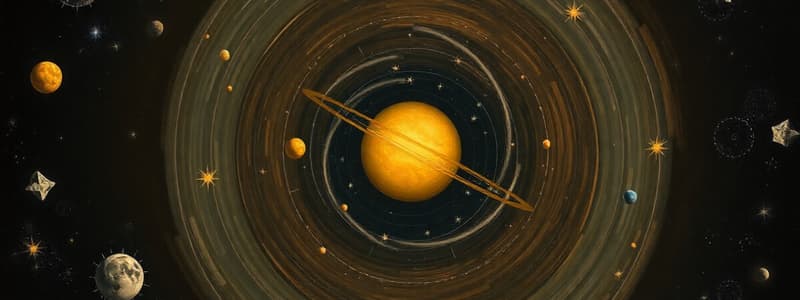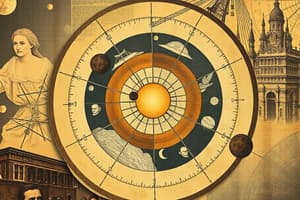Podcast
Questions and Answers
Which of the following best describes the role of protoplanetary disks in planet formation?
Which of the following best describes the role of protoplanetary disks in planet formation?
- They are areas where only rocks and metals can exist in solid form due to high temperatures.
- They contain gas that helps larger pieces of matter stick together, aiding in planet formation. (correct)
- They are formed after the gas giants have cleared out most of the gas and dust from the solar system.
- They are the final stage of planet formation, where gravity pulls together all the remaining material.
Gas giants are smaller than terrestrial planets because they formed later and had less time to accumulate atmospheres.
Gas giants are smaller than terrestrial planets because they formed later and had less time to accumulate atmospheres.
False (B)
Explain how gravity and instantaneous velocity interact to maintain a planet's orbit around the sun.
Explain how gravity and instantaneous velocity interact to maintain a planet's orbit around the sun.
Gravity pulls the planet towards the Sun, while instantaneous velocity keeps the planet moving forward. Together, these forces result in an elliptical orbit.
According to Kepler's First Law, each planet moves along an ________ with the Sun at one focus.
According to Kepler's First Law, each planet moves along an ________ with the Sun at one focus.
Match the following scientists with their contribution to understanding the solar system:
Match the following scientists with their contribution to understanding the solar system:
What happens to the force of gravity between two objects if the distance between them increases?
What happens to the force of gravity between two objects if the distance between them increases?
The geocentric model of the solar system places the Sun at the center.
The geocentric model of the solar system places the Sun at the center.
Which of the following observations made by Galileo Galilei supported the heliocentric model of the solar system?
Which of the following observations made by Galileo Galilei supported the heliocentric model of the solar system?
According to Kepler's First Law, planets move in perfectly circular orbits around the Sun.
According to Kepler's First Law, planets move in perfectly circular orbits around the Sun.
Two objects of different masses are dropped simultaneously near the surface of the Moon. Which statement is most accurate?
Two objects of different masses are dropped simultaneously near the surface of the Moon. Which statement is most accurate?
State Newton's first law of universal gravitation in your own words. Focus on how the variables of mass and distance affect the gravitational force.
State Newton's first law of universal gravitation in your own words. Focus on how the variables of mass and distance affect the gravitational force.
The collapse of a dense cloud of interstellar gas and dust, potentially triggered by a supernova, led to the formation of a solar __________ disk.
The collapse of a dense cloud of interstellar gas and dust, potentially triggered by a supernova, led to the formation of a solar __________ disk.
Match the scientists with their primary contributions to the understanding of the solar system:
Match the scientists with their primary contributions to the understanding of the solar system:
What key process, occurring in the core of the Sun, releases a tremendous amount of energy and sustains the star?
What key process, occurring in the core of the Sun, releases a tremendous amount of energy and sustains the star?
How does Kepler's Second Law describe the speed of a planet as it orbits the Sun?
How does Kepler's Second Law describe the speed of a planet as it orbits the Sun?
What role did Tycho Brahe play in the advancement of astronomy?
What role did Tycho Brahe play in the advancement of astronomy?
Flashcards
Solar System
Solar System
The collection of large and small objects orbiting the Sun.
Heliocentric Model
Heliocentric Model
The model that places the Sun at the center of the solar system.
Geocentric Model
Geocentric Model
The model that places the Earth at the center of the solar system.
Kepler's First Law
Kepler's First Law
Signup and view all the flashcards
Kepler's Second Law
Kepler's Second Law
Signup and view all the flashcards
Kepler's Third Law
Kepler's Third Law
Signup and view all the flashcards
Law of Universal Gravitation
Law of Universal Gravitation
Signup and view all the flashcards
Formation of Solar System
Formation of Solar System
Signup and view all the flashcards
Planetesimals
Planetesimals
Signup and view all the flashcards
Protoplanetary disks
Protoplanetary disks
Signup and view all the flashcards
Terrestrial planet formation
Terrestrial planet formation
Signup and view all the flashcards
Gas giants formation
Gas giants formation
Signup and view all the flashcards
Planetary Orbit Forces
Planetary Orbit Forces
Signup and view all the flashcards
Kepler's 1st Law
Kepler's 1st Law
Signup and view all the flashcards
Perihelion
Perihelion
Signup and view all the flashcards
Study Notes
- The solar system comprises large and small bodies orbiting the sun.
Models of the Solar System
- The heliocentric model posits the Sun as the solar system's center.
- The geocentric model posits Earth at the solar system's center.
- Aristarchus attempted to find relative distances of the sun and moon using ratios.
- Ptolemy's 'wheels on wheels' system enabled accurate predictions of planetary positions.
- Copernicus developed a heliocentric model that included perfect circular planetary paths and the 'wheels-on-wheels' system.
- Brahe accurately predicted planetary motion and catalogued hundreds of stars before the telescope.
- Kepler determined planets orbit the sun in elliptical paths, not perfect circles.
- Galileo observed Jupiter's moons, indicating Earth wasn't the only object that could be orbited, and Venus' phases showed changes in sunlight direction.
Orbits and Kepler's Laws
- An orbit is the path a body follows around another in space.
- Kepler's First Law states planets orbit the Sun in elliptical paths with the Sun at one focus.
- Kepler's Second Law describes the speed at which a planet moves while orbiting the Sun.
- Kepler's Third Law states the square of the orbital period is proportional to the cube of the planet's average distance from the sun.
Universal Gravitation
- The law of universal gravitation states all objects attract each other through gravitational force.
- Newton's law of universal gravitation states gravitational force increases with mass and decreases with distance.
- Centripetal force is an inward force that causes an object to move in a circular path.
Formation of the Solar System
- The solar system formed about 4.5 billion years ago from a dense cloud of interstellar gas and dust.
- The cloud collapsed, potentially due to a supernova shockwave
- This collapse led to the formation of a solar spinning disk.
- Nuclear fusion in the sun occurs when hydrogen atoms combine to form helium, releasing energy.
- Planets formed as clumps smashed into each other, creating larger objects.
- Planetesimals are the building blocks of planets, formed through repeated collisions.
- Protoplanetary disks contain gas that helps stick big pieces together.
- Terrestrial planets formed from rocks and metals in solid form due to the protoplanetary disk's heat.
- Gas giants formed in the cold outer disk, containing ices, gases, rocks, and metals.
- Gas giants are larger due to their age and ability to form large atmospheres from gas.
Gravity
- Gravity prevents planets from flying out into space.
- Instantaneous velocity prevents planets from flying into the sun.
- All people exert gravity.
- As a nebula contracted due to gravity, it began to rotate and formed a protostellar disk where the sun formed.
Key Contributors
- Nicolaus Copernicus proposed the heliocentric model.
- Galileo Galilei used a telescope to support the heliocentric model.
- Claudius Ptolemy modified the geocentric model, suggesting planets travel in small circles as they orbit Earth.
- Johannes Kepler discovered planets orbit in elliptical paths.
- Isaac Newton determined gravity governs planetary movement.
Additional Concepts
- Kepler's 1st Law states each planet moves along an ellipse.
- Perihelion is the point when a planet is closest to the sun in its orbit.
- Parallax is the apparent change in an object's position when viewed from different locations during orbit.
- Gravity is a force of attraction between objects due to their mass and distance.
- Gravity increases as distance decreases and decreases as distance increases.
- Gravity depends on mass and distance.
- As mass increases, gravity increases, and as distance increases, gravity decreases.
- Objects of different masses fall at the same rate near the moon's surface.
- G in F = G m1*m2 / r^2 isThe universal constant of gravity.
Studying That Suits You
Use AI to generate personalized quizzes and flashcards to suit your learning preferences.



